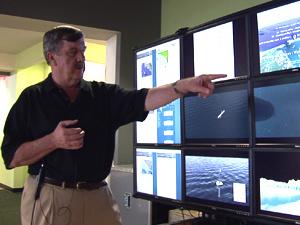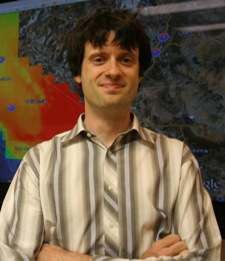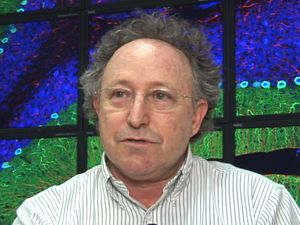La Jolla Research & Innovation Summit, Part Two: Energy, the Environment and Health
By Tiffany Fox, (858) 246-0353, tfox@ucsd.edu
San Diego, Calif., April 26, 2011 — UC San Diego researchers affiliated with Calit2 participated on most of the panels of experts during the third annual La Jolla Research & Innovation Summit. At the April 21 invitation-only event organized by CONNECT, parallel sessions aligned closely with three of the four ‘application thrusts’ in Calit2’s strategic vision for the next decade: energy, the environment and health.
|
(Note to readers: For more on the La Jolla Research & Innovation Summit, click here to read part one of this two-part special report.)
One panel addressed the future of stem cells in medical research (“Regenerative Medicine: A Fresh Outlook for Neuro, Cardio and Cancer”) and another delved into a Calit2-based project that is building a “Virtual Infrastructure” that will become “The Backbone of Environmental Advances.”
Several UCSD faculty members presented the latest developments in virtual infrastructure at the panel chaired by UCSD Geophysics Professor John Orcutt, who is the principal investigator and director of the Ocean Observatories Initiative (OOI) Cyberinfrastructure (CI) project, a collaboration of Calit2, the Scripps Institution of Oceanography and several other institutions. Once fully established, OOI-CI will create a blueprint for digital infrastructure that will allow ocean observatories to collect, process and transmit data 24 hours a day, seven days a week. The cyberinfrastructure will make all of that data available to scientists and classrooms around the world.
Calit2’s Matt Arrott, program manager of OOI-CI and a panelist at the summit, called the National Science Foundation-funded initiative a “new communication regime” and a “whole new way of thinking about networks.”
“We are living in a world where computation is going to live in the network, rather than on the edge” on individual servers, explained Arrott. “The dream of OOI is to create a ‘sense-and-response’ network that will allow for far more collaborative ways of working with data in real time.”
In his talk on enabling technology for health, energy and cyber-physical systems, panelist Ingolf Krueger — a Calit2-affiliated professor of Computer Science and Engineering — predicted that with new developments in cloud computing, “soon we will see our entire genomes traveling, via networks, from one medical provider to another.”
“These types of systems are germane not only to the sciences, but to society in general,” he noted.
OOI-CI co-principal investigator Frank Vernon, a research seismologist at Scripps’ Institute of Geophysics and Planetary Physics, presented a talk on the importance of real-time sensor data with accurate time. Vernon pointed out the difficulties of gathering data for large-scale, global studies like OOI, which must link physical observatory data, computation storage and network infrastructure in real-time for years on end.
“Think about the need to run a system at the same sample rate for a decade,” he added. “We need better real-time sensor data to be able to make predictions” about changes to the ocean environment.
While some venture capitalists chose to attend the virtual infrastructure session, others attended the stem-cell panel, which featured speakers from the Salk Institute for Biological Studies as well as Professor Mark Mercola of the Muscle Development and Regeneration Program in the UC San Diego School of Medicine. Larry Goldstein, UCSD professor of Cellular and Molecular Medicine, moderated the panel and discussed the future of stem cell research in San Diego, which has received more than $264 million in grant funding for use in harnessing the power of stem cells to diagnose, treat and cure degenerative diseases and injuries.
|
“The world took fossil fuels and turned it into food, and that’s what allowed us to get to a population of 7 billion people,” he said. “But with fossil fuels being depleted at an accelerated rate, the country that figures out the energy problem is the country that will dominate the economy. There are other parts of the world that are in for a very rude awakening.”
Keeling, who was the first to discover that oxygen concentration of the global atmosphere is decreasing due to the burning of fossil fuels, discussed the current understanding of the rise in greenhouse gas emissions and the role of government regulation.
He said that although the carbon dioxide levels are expected to reach the symbolic level of 400 parts per million (ppm) in the next few years, measuring greenhouse gas emissions is difficult, in part, because the world lacks a unified system of global sensors.
“Carbon dioxide has reached 390 ppm today and we’re already seeing some profound climate changes” he remarked. “The question is, where are we going with this? The political landscape for regulating carbon dioxide has not gone forward much because of the difficulty in creating a regulatory structure for greenhouse gases when we don’t actually know what’s being emitted. There’s an increased future in understanding the science in this arena of regulation.”
|
Kleissl’s presentation demonstrated that there’s also an increased future in understanding the nuances of short-term solar forecasting. His team’s efforts at UCSD to generate total sky imagery to predict cloud motion vectors has shown 75 percent accuracy in the forecast of clouds within a 30-second range, and those numbers continue to improve.
Calit2-affiliated researchers also figured prominently on the panel on biophotonics, which included UCSD Professor of Neurosciences and Bioengineering Mark Ellisman, who is director and principal investigator of the National Center for Microscopy and Imaging Research, as well as Yuhwa Lo, a professor of Electrical and Computer Engineering at UCSD and director of Calit2’s Nano3 cleanroom facility. In his presentation, Ellisman highlighted new microscopes and genetic marking methods for the Whole Brain Catalog, which generates 3D images of human brains and allows anyone on the web to explore, analyze and contribute to the understanding of the nervous system.
Lo discussed the benefits of using the human retina as a design model to enhance microchips so they are capable of recognizing the entire color spectrum. An increased sensitivity to color makes the microchip a more powerful tool for conducting biomedical diagnostics on a single cell level, noted Lo.
“Eventually the chip will be the size — and hopefully the cost — of a penny,” he added.
In the summit’s keynote presentation, Eric Topol, MD, from The Scripps Research Institute addressed the super-convergence of innovative technologies such as social networks and handheld sensor devices. He said such technologies have the potential to render medicine as we know it obsolete.
“We now have the emerging tools to have the biggest shake-up in the history of medicine,” Topol remarked, adding that such tools can help humans evolve from the ‘homo distractus’ of the plugged-in modern age to the ‘homo digitus’ of an increasingly convergent digital and biological world. “Instead of having a ‘check engine’ light in a car, we’ll soon be able to do that in a human. We are creating the science of individuality.”
Media Contacts
Tiffany Fox, (858) 246-0353, tfox@ucsd.edu
Related Links




